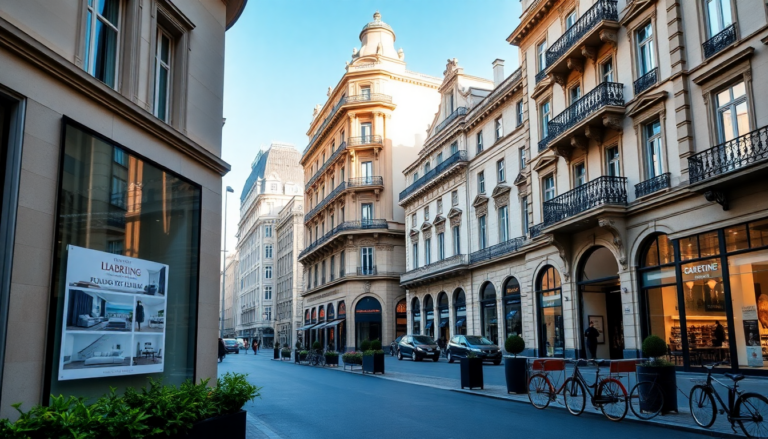Argomenti trattati
The luxury real estate market in Milan is a vibrant and ever-changing scene. It’s influenced by a mix of economic factors and shifting buyer preferences. With over two decades of experience in this sector, I’ve seen the market go through its fair share of booms and recoveries. This journey has reinforced a key point: understanding market dynamics is crucial for anyone looking to invest successfully. In this article, we’ll dive into the current state of Milan’s luxury real estate market, spotlight the hottest areas for investment, and share some practical advice for potential buyers and investors.
Market Overview with OMI/Nomisma Data
Recent data from OMI and Nomisma paints an encouraging picture for the luxury segment of Milan’s real estate market. The demand for high-end properties has shown remarkable resilience, even amidst global economic ups and downs. Prices per square meter in prime locations are holding strong, proving that Milan remains a top destination for luxury living.
When it comes to property valuation, location is everything. Areas like Brera, the historic center, and the emerging neighborhoods of Porta Nuova are experiencing a price surge. This uptick is driven by both domestic and international buyers clamoring for quality real estate. The data reveals that properties in these coveted spots not only command higher prices but also sell faster, indicating a competitive market environment.
Additionally, the luxury market is thriving thanks to a growing interest in lifestyle-driven amenities—think proximity to cultural hotspots, gourmet dining, and upscale shopping. This shift in buyer preferences highlights just how crucial location has become in the decision-making process.
Analysis of Attractive Areas and Property Types
Identifying the most attractive areas for investment means pinpointing neighborhoods that are gaining traction among luxury buyers. The historic center, especially around the Duomo, continues to draw affluent buyers due to its cultural significance and lively atmosphere. Properties here offer not just immediate access to Milan’s rich heritage but also the promise of long-term appreciation.
On the flip side, neighborhoods like Isola and Porta Romana are becoming increasingly appealing for their contemporary lifestyle offerings and innovative developments. These areas attract younger professionals and expatriates who are looking for a mix of modern living and cultural experiences. Investors should keep a close eye on these neighborhoods as they represent potential growth and solid ROI.
When considering property types, luxury apartments are dominating the scene, particularly those equipped with modern amenities and sustainable design elements. Buyers are now more inclined to look for properties that not only meet their immediate needs but also resonate with their lifestyle choices—think energy efficiency and smart home technology. Therefore, properties that seamlessly blend luxury with sustainability are poised to thrive in the years ahead.
Price Trends and Investment Opportunities
The upward trend in prices within Milan’s luxury real estate market paints a positive picture for investors. While external economic factors might cause some fluctuations, the demand for high-end properties remains robust. The luxury real estate sector is often less sensitive to economic downturns, making it a relatively stable investment compared to other asset classes.
If you’re contemplating entering the market, there are several exciting opportunities to explore. For savvy investors, off-market transactions and pre-construction sales offer unique chances to secure properties at competitive prices. Additionally, investing in properties that require renovation can lead to significant returns—especially in sought-after locations where demand outstrips supply.
It’s also vital for investors to grasp the financial metrics that underpin successful real estate investments. Key indicators such as cap rate, cash flow, and projected appreciation should guide your decision-making process. By focusing on properties with strong potential for ROI, you can seize the lucrative opportunities that Milan’s luxury market has to offer.
Practical Advice for Buyers and Investors
For those looking to buy or invest, understanding the intricacies of the luxury real estate market is essential for making informed decisions. First and foremost, thorough research is key. Familiarize yourself with market trends, property values, and the unique characteristics of different neighborhoods. Partnering with experienced local agents can provide invaluable insights and help streamline transactions.
Moreover, potential buyers should think about their long-term goals. Whether you’re searching for a primary residence or an investment property, having a clear vision will guide your choices regarding location and property type. Staying flexible and adapting to market changes can also enhance your chances of success.
Lastly, conducting due diligence before committing to a property is crucial. This includes reviewing financial documents, understanding the property’s valuation, and assessing its potential for future appreciation. By taking a proactive approach, buyers can navigate the complexities of the luxury market with greater confidence.
Medium-Term Forecasts
Looking ahead, the medium-term outlook for Milan’s luxury real estate market remains bright. As the city continues to solidify its reputation as a global hub for business, culture, and innovation, the demand for high-end properties is likely to remain strong. Urban development projects and improvements in infrastructure will only enhance Milan’s appeal as a prime investment destination.
Additionally, increased interest from international buyers, particularly from Asia and the Middle East, is expected to drive competition and contribute to rising property values. As more buyers seek the prestige that comes with owning luxury real estate in Milan, the market stands ready for sustained growth.
In conclusion, Milan’s luxury real estate market is brimming with opportunities for discerning buyers and investors. By staying informed about market dynamics, recognizing the importance of location, and making strategic investment choices, you can navigate this dynamic landscape with success.

